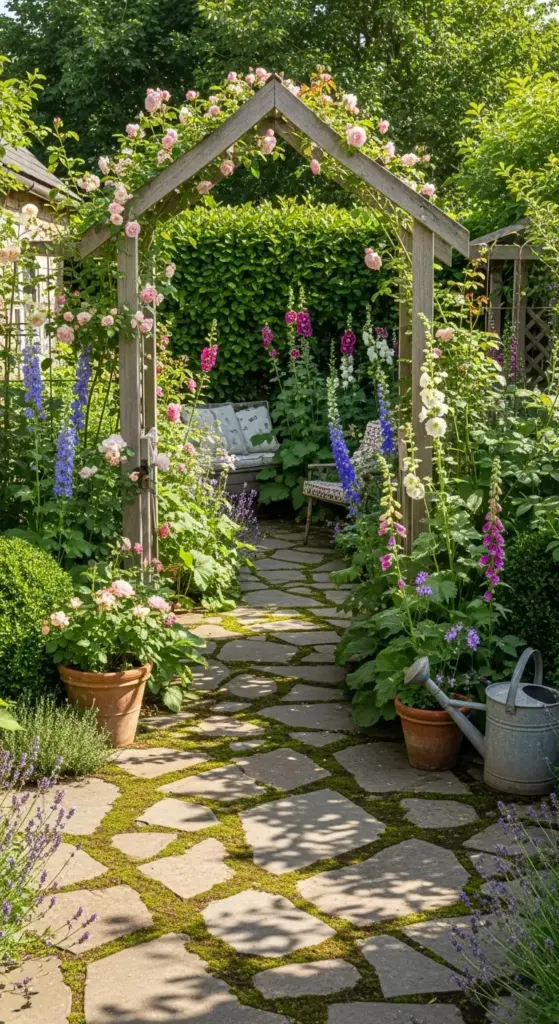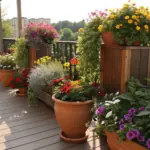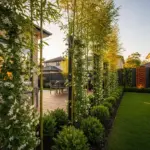7. Cottage Garden Patio Design

After years of creating structured, planned outdoor spaces, I found myself yearning for something that felt more organic and romantic. You know that feeling when you see an old English cottage garden and think “I want to live there”?
That’s exactly what inspired my cottage garden patio design. I wanted a space that looked like it had evolved naturally over decades, with flowers spilling everywhere and hidden seating nooks.
Little did I know this would become my most challenging project yet – turns out “effortless” cottage gardens require way more planning than you’d think!
Creating English Garden-Style Plantings
My first mistake was thinking I could just scatter some flower seeds around and achieve that lush cottage garden look. Six months later, I had a weedy mess instead of romantic abundance.
English garden-style plantings require careful planning to look naturally unplanned. The secret is layering plants of different heights, textures, and bloom times.
I started with foundation plantings like boxwood hedges and lavender borders to create structure. These evergreen elements provide year-round backbone for the more dramatic seasonal flowers.
Perennial flowers became my obsession. I planted delphiniums, hollyhocks, and foxgloves for dramatic height, with catmint, lady’s mantle, and hardy geraniums filling the middle layer.
The key is repetition with variation. I planted the same varieties in multiple spots but in different combinations, creating that natural drift effect you see in established cottage gardens.
Self-seeding annuals like cosmos, nigella, and sweet alyssum fill in gaps and create happy accidents. After three years, they’ve naturalized and pop up in the most perfect unexpected places.
I learned that cottage garden plants need rich, well-draining soil. I spent a fortune on compost and soil amendments, but it was absolutely worth it for the incredible growth and bloom performance.
The biggest challenge was restraint. I wanted to plant everything I saw at the nursery. Now I stick to a cohesive color palette of soft pinks, purples, whites, and blues with touches of yellow.
Choosing Natural Flagstone and Irregular Pavers
Regular rectangular pavers would’ve completely ruined the cottage garden aesthetic I was going for. Natural flagstone was the obvious choice, but finding the right pieces was harder than expected.
I initially bought the cheapest flagstone I could find, thinking stone was stone. Those uniform gray pieces looked like a sidewalk, not a romantic garden path.
Real cottage garden paving needs character and variation. I ended up sourcing reclaimed Yorkshire stone with beautiful color variations and natural weathering.
Irregular pavers create that organic, hand-laid look that’s essential for authentic cottage style. No two pieces are exactly the same size or shape.
The installation was tricky because irregular stones don’t fit together like puzzle pieces. I had to cut and adjust each piece individually, which took forever but created perfect custom fit.
Gaps between stones are filled with creeping thyme and moss instead of mortar. This softens the hard edges and allows plants to naturalize between the pavers.
I learned to embrace imperfection. Slightly wobbly stones and uneven surfaces add character that you can’t get with perfectly level modern installation.
The flagstone cost about $12 per square foot installed, but it’s developed this incredible patina over three years that just gets more beautiful with age.
Installing Climbing Roses on Trellises and Arbors
This is where I made my most spectacular mistake – and accidentally created my favorite garden feature. I planted climbing roses without properly researching their growth habits.
Within two years, my “David Austin” climbing rose had completely engulfed my neighbor’s fence and was heading for their roof.
Climbing roses need serious support structures and regular pruning to stay manageable. I learned this the expensive way when I had to hire professionals to untangle the monster I’d created.
The new setup includes custom cedar trellises and a beautiful arbor entrance that can actually handle vigorous climbing roses. The structures are built to last and look intentionally rustic.
I chose repeat-blooming varieties like ‘New Dawn’ and ‘Eden’ that flower multiple times per season instead of just once. The fragrance when you walk through the arbor is absolutely incredible.
Training the roses properly from the start is crucial. I tie new growth horizontally along the trellis supports, which encourages more blooms and prevents the roses from just shooting straight up.
Companion plantings at the base of each rose include clematis for extended bloom time and lavender for fragrance and pest control. The combinations are stunning.
The arbor installation cost $1,800, but it’s become the signature feature of my cottage garden. Everyone wants photos under those rose-covered arches.
Vintage Garden Accessories and Planters
Vintage accessories can make or break a cottage garden design. My first attempt looked like I’d raided a flea market and dumped everything randomly around the patio.
Too much vintage stuff just looks cluttered, not charming.
The secret is choosing pieces that look like they’ve always been there. I have an old galvanized watering can that I actually use, and a weathered wooden wheelbarrow that serves as a planter.
Vintage planters add instant age and character. I found amazing old terracotta pots at estate sales and antique shops. Each one has chips and stains that tell a story.
My favorite piece is an antique garden gate that I use as a trellis for sweet peas. It doesn’t go anywhere – it’s purely decorative – but it adds incredible vertical interest and history.
Repurposed items work beautifully in cottage gardens. I have an old enamel colander that makes a perfect planter for trailing nasturtiums, and vintage mason jars that hold cut flowers.
The key is patina and authenticity. New items made to look old never have the same character as genuinely aged pieces.
I also use natural materials like woven baskets and wooden crates for seasonal displays. They weather beautifully and blend seamlessly with the garden aesthetic.
Designing Intimate Seating Nooks
Cottage garden seating should feel discovered, not obvious. I wanted little hideaways where you could sit quietly and feel completely surrounded by flowers.
My first seating area was just a bench plunked in the middle of everything. It felt exposed and awkward, not intimate at all.
I created three separate seating nooks in different areas of the garden, each with its own character and purpose. One for morning coffee, one for afternoon reading, and one for evening wine.
The morning nook faces east and is surrounded by fragrant herbs like rosemary and lavender. I have a small bistro table and two chairs tucked between tall delphiniums.
My reading corner is partially enclosed by a trellis screen covered in climbing jasmine. The bench has weatherproof cushions and a small side table for books and tea.
The evening spot catches the last rays of sun and is surrounded by night-blooming flowers like four o’clocks and evening primrose. The fragrance at dusk is absolutely magical.
Privacy screening uses plants instead of fences. Tall ornamental grasses, climbing roses, and layered shrubs create natural walls that feel organic, not constructed.
Each nook includes weatherproof storage for cushions and garden tools, disguised as decorative elements like vintage crates or stone planters.
Seasonal Planting Guide for Year-Round Beauty
Cottage gardens can look amazing in every season, but it requires careful planning to ensure continuous interest throughout the year.
Spring is all about bulbs and early perennials. I have thousands of daffodils, tulips, and crocuses naturalized throughout the garden, plus early-blooming hellebores and pulmonaria.
Summer is peak cottage garden season. Roses, delphiniums, hollyhocks, and sweet peas create the classic romantic abundance everyone pictures.
My biggest learning was about succession planting. I plant cosmos and zinnias every three weeks from spring through midsummer to ensure continuous blooms until frost.
Fall brings asters, chrysanthemums, and ornamental grasses into their glory. I also have late-blooming roses that provide color well into October.
Winter structure comes from evergreen shrubs, ornamental grasses left standing, and interesting seed heads. Don’t cut everything back in fall – winter gardens need texture too.
Seasonal containers let me add pops of color exactly where needed. Spring pansies, summer petunias, fall mums, and winter evergreen arrangements keep the patio areas looking fresh.
I learned to embrace the seasons instead of fighting them. Each time of year has its own beauty in a cottage garden – you just need to plan for it.
Maintenance is ongoing but rewarding. Deadheading, dividing perennials, and seasonal cleanup keep everything looking abundant but not overgrown.
The key is working with natural cycles instead of against them. A cottage garden should feel like a partnership with nature, not a battle against it.
After four years, my cottage garden patio has that established, timeless look I was dreaming of. Plants have self-seeded in perfect spots, the flagstone has developed beautiful moss and patina, and every season brings new surprises and delights.
Conclusion
These seven insider patio designs prove that you don’t need a massive budget to create a stunning outdoor space that adds serious value to your home. From the Mediterranean oasis perfect for your next dinner party to the zen retreat ideal for morning meditation, each design offers unique benefits for today’s busy homeowner.
Remember, the key to maximizing your investment lies in choosing quality materials, incorporating plants that thrive in your climate, and creating functional spaces that reflect your lifestyle. Whether you’re in bustling New York or sunny Los Angeles, these designs can be adapted to suit your local environment and personal style.
Ready to transform your backyard into a valuable asset? Start with one design that speaks to you, and watch as your outdoor space becomes the envy of the neighborhood – and a smart financial investment for years to come!









GIPHY App Key not set. Please check settings